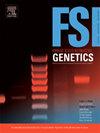具有部分特定假设的亲属关系案例
IF 3.1
2区 医学
Q2 GENETICS & HEREDITY
引用次数: 0
摘要
法医亲属检验是对一组假设的亲属关系进行统计比较,其依据是来自相关个人和可能的其他亲属的遗传标记数据。在大多数情况下,每个假设都是根据谱系完全指定的,但在更复杂的情况下并非总是如此。例如,假设我们被要求测试H1: A是B的祖母,而H2: A和B无关,并且数据还包括第三个人,其与其他个人的关系不确定。然后可能会有与每个假设一致的多个谱系,其结果是标准似然比(LR)无法计算,除非为所有选择指定了先验概率。为了应对这些挑战,我们引入了广义似然比(GLR),定义为给定H1的数据的最大似然与给定H2的最大似然之比。这类似于经典假设检验中使用的LR检验,但在几个方面有所不同。最重要的是,在取证设置中,我们通常考虑离散的替代方案,而不是连续的参数空间。GLR统计的属性是通过亲属关系测试和灾难受害者识别(DVI)的现实例子来探索的。特别是,我们展示了GLR如何帮助解决和报告复杂DVI病例的结果。作为最后一个应用,我们演示了GLR如何用于检查系谱数据的正确性,这是涉及相关个体基因型的项目中必不可少的质量控制步骤。与其他示例不同,这个示例在连续参数空间上操作,使经典统计工具能够指导决策。本文章由计算机程序翻译,如有差异,请以英文原文为准。
Kinship cases with partially specified hypotheses
Forensic kinship testing is the statistical comparison of a set of hypothesised relationships, based on genetic marker data from the individuals in question and possibly other relatives. In most circumstances each hypothesis is completely specified in terms of a pedigree, but this is not always the case in more complex scenarios. For example, suppose that we are asked to test : A is the grandmother of B, against : A and B are unrelated, and that the data also includes a third individual whose relationship with the others is uncertain. There may then be multiple pedigrees consistent with each hypothesis, with the consequence that the standard likelihood ratio (LR) cannot be calculated unless prior probabilities are specified for all alternatives.
In response to these challenges we introduce a generalised likelihood ratio (GLR), defined as the ratio of the maximal likelihood of the data given to the maximal given . This resembles a version of the LR test used in classical hypothesis testing, but differs in several aspects. Most importantly, in the forensic setting we usually consider discrete alternatives rather than continuous parameter spaces.
The properties of the GLR statistic are explored through real-life examples of kinship testing and disaster victim identification (DVI). In particular, we demonstrate how the GLR may help to resolve and report the results in complex DVI cases. As a final application we demonstrate how the GLR can be used to check correctness of pedigree data, an essential quality control step in projects involving genotypes from related individuals. Unlike the other examples, this one operates over a continuous parameter space, enabling tools from classical statistics to guide decision-making.
求助全文
通过发布文献求助,成功后即可免费获取论文全文。
去求助
来源期刊
CiteScore
7.50
自引率
32.30%
发文量
132
审稿时长
11.3 weeks
期刊介绍:
Forensic Science International: Genetics is the premier journal in the field of Forensic Genetics. This branch of Forensic Science can be defined as the application of genetics to human and non-human material (in the sense of a science with the purpose of studying inherited characteristics for the analysis of inter- and intra-specific variations in populations) for the resolution of legal conflicts.
The scope of the journal includes:
Forensic applications of human polymorphism.
Testing of paternity and other family relationships, immigration cases, typing of biological stains and tissues from criminal casework, identification of human remains by DNA testing methodologies.
Description of human polymorphisms of forensic interest, with special interest in DNA polymorphisms.
Autosomal DNA polymorphisms, mini- and microsatellites (or short tandem repeats, STRs), single nucleotide polymorphisms (SNPs), X and Y chromosome polymorphisms, mtDNA polymorphisms, and any other type of DNA variation with potential forensic applications.
Non-human DNA polymorphisms for crime scene investigation.
Population genetics of human polymorphisms of forensic interest.
Population data, especially from DNA polymorphisms of interest for the solution of forensic problems.
DNA typing methodologies and strategies.
Biostatistical methods in forensic genetics.
Evaluation of DNA evidence in forensic problems (such as paternity or immigration cases, criminal casework, identification), classical and new statistical approaches.
Standards in forensic genetics.
Recommendations of regulatory bodies concerning methods, markers, interpretation or strategies or proposals for procedural or technical standards.
Quality control.
Quality control and quality assurance strategies, proficiency testing for DNA typing methodologies.
Criminal DNA databases.
Technical, legal and statistical issues.
General ethical and legal issues related to forensic genetics.

 求助内容:
求助内容: 应助结果提醒方式:
应助结果提醒方式:


